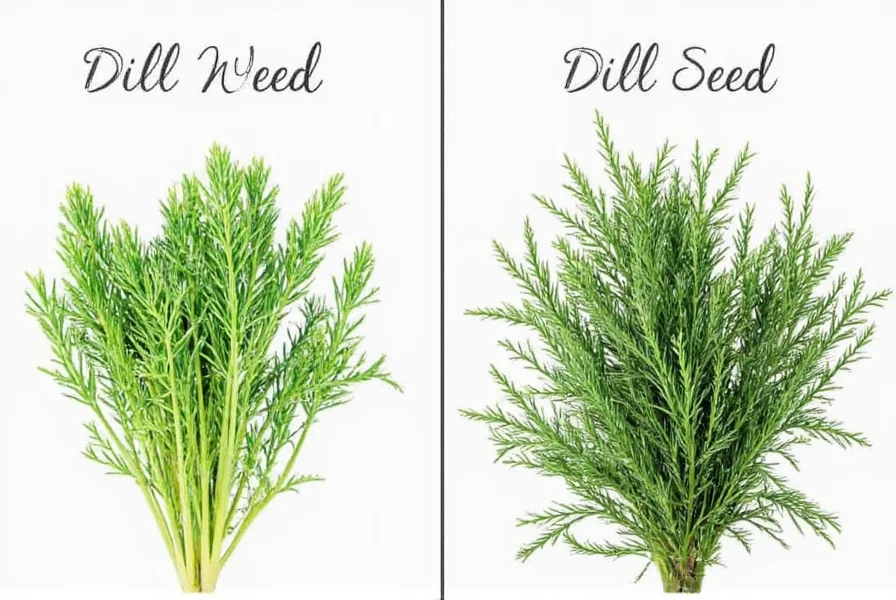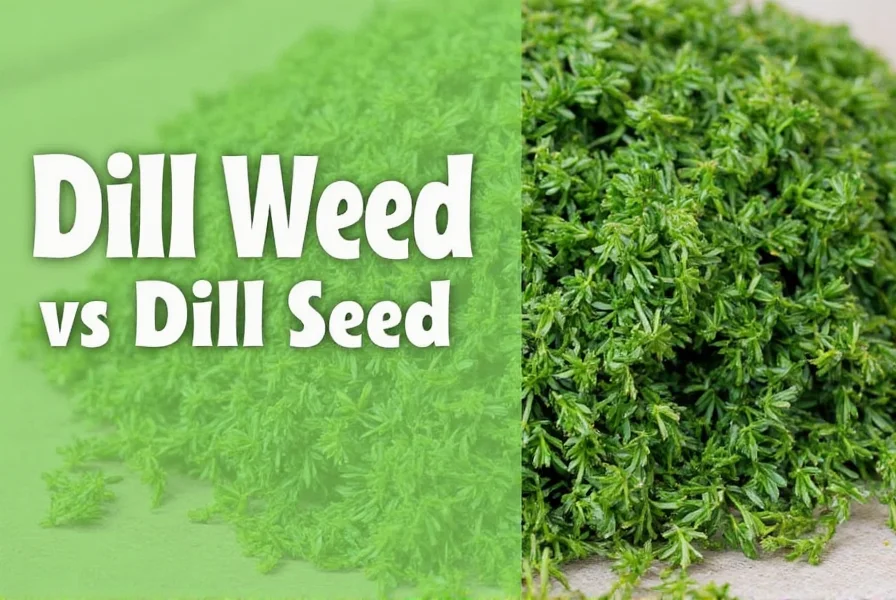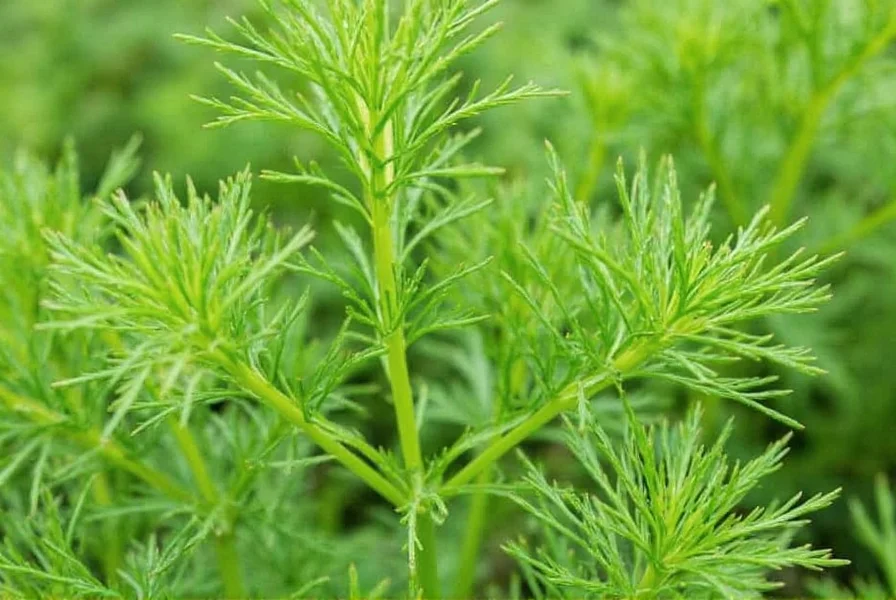Understanding the difference between dill weed and dill seed is essential for achieving perfect flavor in your cooking. While both originate from the same aromatic herb plant, they're harvested at different growth stages and serve unique purposes in the kitchen. Dill weed provides a fresh, grassy flavor ideal for delicate dishes, while dill seed delivers a stronger, slightly citrusy taste with warm undertones perfect for pickling and hearty recipes.
What Exactly Are Dill Weed and Dill Seed?
Dill weed consists of the fresh or dried leaves and tender stems of the dill plant. When harvested young, these feathery fronds offer a delicate anise-like flavor with subtle grassy notes. Chefs often use fresh dill weed as a finishing herb to preserve its nuanced taste.
Dill seed, by contrast, develops later in the plant's lifecycle when the flowers mature into small oval fruits. These tan-colored seeds contain concentrated essential oils that create a more robust, slightly bitter flavor with hints of caraway and citrus. The seeds become fully mature and ready for harvest when they turn from green to brown.
| Characteristic | Dill Weed | Dill Seed |
|---|---|---|
| Plant Part | Leaves and tender stems | Mature fruit (seeds) |
| Flavor Profile | Fresh, grassy, delicate anise | Stronger, citrusy, warm, slightly bitter |
| Best Used In | Fish dishes, salads, dips, dressings | Pickling, breads, stews, sauerkraut |
| Substitution Ratio | 1 tablespoon fresh = 1 teaspoon dried | 1 teaspoon seeds = 1-2 tablespoons weed |
| Storage Life | Fresh: 7-10 days; Dried: 6-12 months | 2-3 years in airtight container |
Flavor Differences That Matter in Cooking
When considering can I substitute dill seed for dill weed in your recipes, understanding their flavor chemistry is crucial. Dill weed contains volatile oils that dissipate quickly when heated, making it ideal as a finishing herb. The primary compound, carvone, gives fresh dill its characteristic clean, green flavor.
Dill seed, however, contains higher concentrations of limonene and other compounds that create a more complex, warming flavor that actually improves with cooking. This explains why dill seed and dill weed substitution ratios aren't equal—one teaspoon of dill seed typically equals one to two tablespoons of dill weed due to the seed's more concentrated flavor.

When to Use Each: Practical Culinary Guidance
Professional chefs understand that selecting between dill weed and dill seed can make or break a dish. For dill weed and dill seed flavor differences in application:
- Use dill weed when you want a bright, fresh flavor in cold dishes like tzatziki, potato salad, or as a garnish for smoked salmon. Add fresh dill weed during the last few minutes of cooking or as a finishing touch.
- Choose dill seed for recipes requiring robust flavor that withstands cooking, such as pickles, sauerkraut, rye bread, or hearty stews. Whole seeds work best for pickling, while crushed seeds enhance breads and spice rubs.
Many home cooks wonder when to use dill seed instead of dill weed—the answer depends on your desired flavor intensity and cooking method. For quick-cooking dishes or raw preparations, dill weed shines. For longer-cooked dishes or preserved foods, dill seed provides better flavor stability.

Storage Tips for Maximum Freshness
Proper storage significantly impacts how long you can enjoy authentic dill flavor. Fresh dill weed lasts 7-10 days when stored upright in a glass of water (like flowers) with a plastic bag loosely covering the leaves, refrigerated. For longer storage, freeze fresh dill weed in ice cube trays with water or oil.
Dried dill weed maintains quality for 6-12 months in an airtight container away from light and heat. Dill seed, with its higher oil content, stays potent for 2-3 years when stored properly. Never store either near your stove or in clear containers where light can degrade the essential oils.
Growing Your Own Dill for Fresh Supply
For gardeners interested in dill plant parts explained, growing dill is relatively straightforward. The plant prefers full sun and well-draining soil. Harvest dill weed when the plant reaches 8-12 inches tall, taking outer stems first to encourage bushier growth. For dill seed production, allow some flower heads to mature fully until seeds turn brown, then cut the entire seed head and dry it upside down in a paper bag.
Common Mistakes to Avoid
Many cooks make these errors when working with dill:
- Using dried dill weed as a 1:1 substitute for fresh (use one-third the amount)
- Adding fresh dill weed too early in the cooking process
- Using dill seed in delicate fish dishes where its strong flavor overwhelms
- Storing dill near strong-smelling foods like onions (it readily absorbs odors)
Frequently Asked Questions
Can I substitute dill seed for dill weed in recipes?
Yes, but not at a 1:1 ratio. Generally, 1 teaspoon of dill seed equals 1-2 tablespoons of dill weed. Dill seed has a stronger, more concentrated flavor, so use less when substituting. For delicate dishes like fish or salads, dill weed is preferable, while dill seed works better in pickling and hearty cooked dishes.
Which has stronger flavor: dill weed or dill seed?
Dill seed has a stronger, more concentrated flavor than dill weed. The seeds contain higher levels of essential oils, creating a warm, slightly citrusy taste with hints of caraway. Dill weed offers a more delicate, fresh grassy flavor that dissipates with heat, making it better for finishing dishes rather than long cooking.
What's the best way to store fresh dill weed?
Store fresh dill weed upright in a glass with about an inch of water, like cut flowers. Cover loosely with a plastic bag and refrigerate. Change the water every 2-3 days. Properly stored, fresh dill lasts 7-10 days. For longer storage, freeze dill in ice cube trays with water or oil.
Can I grow dill weed and collect dill seed from the same plant?
Yes, you can harvest both from the same dill plant. Pick the feathery leaves (dill weed) when the plant is 8-12 inches tall. Allow some flower heads to mature fully until the seeds turn brown, then cut the seed heads and dry them upside down in a paper bag to collect the dill seeds.











 浙公网安备
33010002000092号
浙公网安备
33010002000092号 浙B2-20120091-4
浙B2-20120091-4